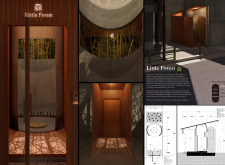5 key facts about this project
The architectural concept is grounded in biophilic design principles, which foster connections between humans and their natural surroundings. The "Little Forest" manifests these concepts through a careful selection of materials, spatial organization, and landscaping that reflect the characteristics of a forest environment.
Space Utilization and Form
The project employs a circular layout that symbolizes unity and wholeness. The central meditation area, characterized by a circular wooden platform, serves as the focal point for reflection and mindfulness activities. Surrounding spaces are designed to provide varying degrees of enclosure, helping to create an intimate setting that channels focus towards the central area.
The entrance features a deliberately narrow passage that contrasts with the openness inside, facilitating a psychological transition from the outside urban environment to a calming interior. The emphasis on natural light is evident through large glass elements strategically placed to maximize daylight exposure, enhancing the natural ambiance throughout the day.
Unique Design Approaches
A distinguishing feature of "Little Forest" is its innovative use of materials, which includes wood, concrete, and glass. The warmth of wood creates an inviting atmosphere, while the solidity of concrete ensures structural integrity. Glass elements not only facilitate visual connections with the external environment but also contribute to energy efficiency through natural lighting.
The landscaping integrates indigenous plants, including bamboo, that evoke a forest-like experience within the urban setting. This design approach highlights the project’s commitment to maintaining ecological sensitivity while enhancing user experience. The incorporation of nature through vegetation not only improves aesthetic value but also promotes a sense of well-being among those who utilize the space.
Architectural Composition and Environment Integration
The architectural composition of "Little Forest" is characterized by the interplay of different textures and forms. The combination of smooth concrete surfaces with the organic appeal of wooden elements creates a deliberate contrast that adds depth to the design. This interplay is further enriched by the strategically designed lighting, which highlights various features within the space.
The project stands apart from conventional urban designs by effectively addressing the psychological and emotional needs of its users. It promotes relaxation and introspection, demonstrating how architecture can contribute positively to mental health in urban settings. By fostering a direct connection to nature, "Little Forest" advocates for the importance of green spaces in improving the quality of urban life.
For more detailed insights into the "Little Forest" project, including architectural plans, sections, and specific design elements, readers are encouraged to explore the complete project presentation. The thoughtful design decisions made for this project provide valuable architectural ideas for future developments aimed at enhancing urban living conditions.























